Journal of Modern Physics
Vol. 2 No. 8 (2011) , Article ID: 6677 , 5 pages DOI:10.4236/jmp.2011.28092
Spin Dependent Selection Rules for Photonic Transitions in Hydrogen-Like Atoms
1Department of Physics, Faculty of Science, Aksaray University, Aksaray, Turkey
2Department of Physics and Astronomy, King Saud University, Riyadh, Saudi Arabia
3Department of Physics, Ankara University, Tandogan, Ankara, Turkey
E-mail: zsaglam@aksaray.edu.tr, saglam@science.ankara.edu.tr
Received March 22, 2011; revised April 28, 2011; accepted May 19, 2011
Keywords: Dirac Hydrogen Atom, Hydrogen-Like (Hydrogenic) Atoms, Photonic Transitions, Selection Rules, Fermi-Golden Rule, Transition Rate
ABSTRACT
Spin dependent selection rules for photonic transitions in hydrogen-like atoms is derived by using the solution of Dirac equation for hydrogen-like atoms. It is shown that photonic transitions occur when [ while
while ]. By applying the spin dependent selection rules, we can explain the observed (6 s
]. By applying the spin dependent selection rules, we can explain the observed (6 s 7 s) transition in Cesium (Cs) atom.
7 s) transition in Cesium (Cs) atom.
1. Introduction
Applications of hydrogen-like atoms in technology are more than the hydrogen atom itself. Accurate determination of the excited-state properties of atomic and molecular systems, such as fine and hyperfine coupling constants, oscillator strengths play important roles for testing the high-precision atomic theory and quantum mechanics. The aim of the present study is to find spin dependent selection rules for photonic transitions in hydrogen-like atoms. We first derive the spin dependent eigenstates of the hydrogen-like atoms then find a more accurate correspondence between these eigenstates. So far in literature the states have been denoted by the quantum numbers (n, l, j) [1] but not by the quantum numbers (n, l, mj). In this way, we distinguish the states in the Zeeman sense including the quantum number, mj. By using the Fermi-Golden rule, we calculate the non-zero matrix elements and then develop the spin dependent selection rules for the photonic transitions in the hydrogen-like atoms. We show that photonic transitions occur when  and
and . By applying the spin dependent selection rules, we can explain the observed
. By applying the spin dependent selection rules, we can explain the observed  transition in Cesium (Cs) atom. The outline of the present study is as follows. In Section 2 we give a short summary of the Dirac hydrogen atom and then extend it to the hydrogen-like atoms. In Section 3 we develop the spin dependent transition rates for Dirac hydrogen-like atoms. In Section 4 we give the explanation of the (6 s - 7 s) transition of Cs in terms of the spin dependent selection rules. In Section 5 we give the conclusions.
transition in Cesium (Cs) atom. The outline of the present study is as follows. In Section 2 we give a short summary of the Dirac hydrogen atom and then extend it to the hydrogen-like atoms. In Section 3 we develop the spin dependent transition rates for Dirac hydrogen-like atoms. In Section 4 we give the explanation of the (6 s - 7 s) transition of Cs in terms of the spin dependent selection rules. In Section 5 we give the conclusions.
2. The Dirac Hydrogen Atom
To find the eigenvalue of the Dirac hydrogen-like atom, we will begin with the Dirac Hamiltonian of the hydrogen atom [2-4]:
 (1)
(1)
where  is the Coulomb potential, m is the mass of an electron, c is the velocity of light,
is the Coulomb potential, m is the mass of an electron, c is the velocity of light,  and
and  are the standard Dirac matrices in the Dirac representation:
are the standard Dirac matrices in the Dirac representation:
 (2)
(2)
Here the 1's and 0's stand for 2 × 2 unit and zero matrices respectively and the  is the standard vector composed of the three Pauli matrices
is the standard vector composed of the three Pauli matrices . Since the Hamiltonian is invariant under rotations, we look for simultaneous eigenfunctions of HD, |J|2, and Jz, where
. Since the Hamiltonian is invariant under rotations, we look for simultaneous eigenfunctions of HD, |J|2, and Jz, where
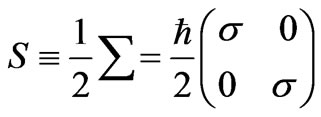 (3a)
(3a)
and Jz = Lz + Sz or mj = m + ms(3b)
We remark that the spin operator is diagonal in terms of 2 × 2 Pauli spin matrices; therefore the angular part should be precisely that of the Pauli two-component theory. Defining
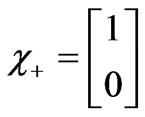 and
and 
the spin dependent wave functions can be written as [5]:
 (4a)
(4a)
 (4b)
(4b)
where  is the radial wave function,
is the radial wave function,  are the spherical harmonics. Further in Equation (4a),
are the spherical harmonics. Further in Equation (4a),  can be replaced by (
can be replaced by ( ) (spin-up case);and in Equation(4b),
) (spin-up case);and in Equation(4b),  can be replaced by
can be replaced by  (spin-down case). In a hydro-gen-like atom the potential
(spin-down case). In a hydro-gen-like atom the potential  is replaced by
is replaced by , where Z is the atomic number. So the spin dependent eigenfunctions for hydrogen-like atoms are written as:
, where Z is the atomic number. So the spin dependent eigenfunctions for hydrogen-like atoms are written as:
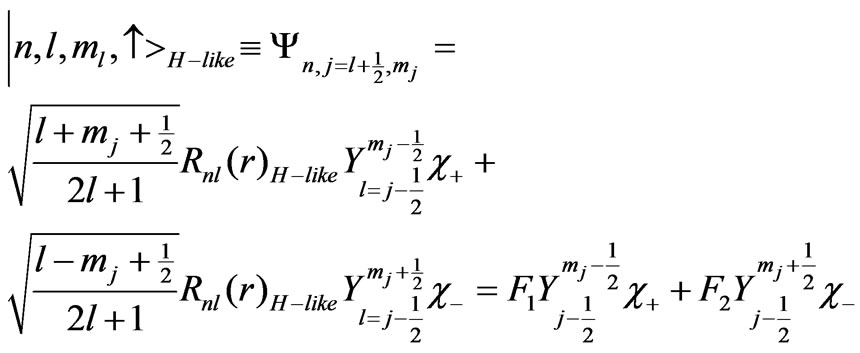 (5a)
(5a)
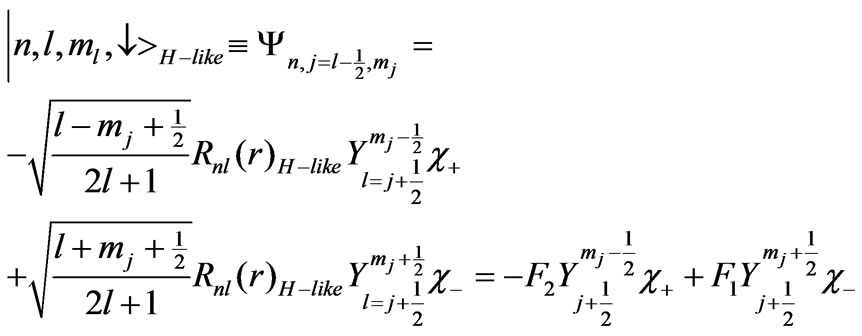 (5b)
(5b)
where
 (5c)
(5c)
Here  are the Laguerre polynomials and
are the Laguerre polynomials and  is the Bohr radius.
is the Bohr radius.
3. Developing Spin Dependent Transition Rates for Photonic Transitions in Dirac Hydrogen-Like Atoms
To develop the spin dependent selection rules for hydrogen-like atoms, we need to consider energy shifts coming from the electric field E and the magnetic field B separately. When the atom is subject to an external electric and magnetic field, it will have interactions through the Hamiltonians:  and
and .
.
However, the electric and the magnetic field of a photon are not independent fields and they are related to each other with the same vector potential  which obeys the Coulomb gauge condition (
which obeys the Coulomb gauge condition ( ). In this case the electric and the magnetic field vectors are given by:
). In this case the electric and the magnetic field vectors are given by:
 (6a)
(6a)
and
 (6b)
(6b)
where  is the wave vector of the photon.
is the wave vector of the photon.
In general the effect of the vector potential  on electron is considered through the canonical momentum that produces an interaction potential
on electron is considered through the canonical momentum that produces an interaction potential  which has the linear and the quadratic terms [6]:
which has the linear and the quadratic terms [6]:
 (7)
(7)
where  is the linear momentum of the electron.
is the linear momentum of the electron.
We will see that to develop the selection rules for photonic transitions, the Hamiltonian  will be adequate and the Hamiltonian
will be adequate and the Hamiltonian  will not produce anything new.
will not produce anything new.
Let us first start with the effect of the electric field. In Dirac notations, if at t = 0 the electron is at an initial state
| i > º
given by Equation (5a) and Equation (5b), then at t > 0, because of the interaction with H', there will be a non-zero transition rate to some other states
| f >
which will be called the final states. According to the Golden rule, the transition probability will be proportional to the square of the matrix element of H' between the initial and the final states: . To calculate the matrix element
. To calculate the matrix element , we follow a similar way as followed by Saglam et al. [5]. Namely we will consider two different cases: a) The polarization of the electric field is in x-y plane (along the xor the y-axis) b) The polarization of the electric field is in z-direction. Since the dipole moment vector
, we follow a similar way as followed by Saglam et al. [5]. Namely we will consider two different cases: a) The polarization of the electric field is in x-y plane (along the xor the y-axis) b) The polarization of the electric field is in z-direction. Since the dipole moment vector  is equal to (
is equal to ( ), for the case a), we calculate the matrix elements of the quantities x ± iy= rsinq exp(±if) and for the case b) we calculate the matrix elements of the quantity: rcos q. For the case a) we can write:
), for the case a), we calculate the matrix elements of the quantities x ± iy= rsinq exp(±if) and for the case b) we calculate the matrix elements of the quantity: rcos q. For the case a) we can write:




 .
.
 (8)
(8)
Substitution of Equation (5a) in  we obtain:
we obtain:
 (9)
(9)
which will be non-zero for:
 ;
; (10a)
(10a)
 ;
; (10b)
(10b)
To evaluate the integral (9) we have used the relation:
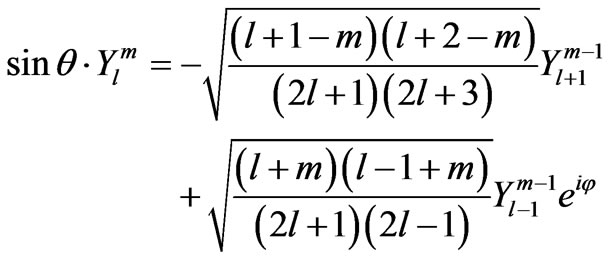 (11)
(11)
Next substituting Equation (5b) in  we obtain:
we obtain:
 (12)
(12)
which will be non-zero for:
 ;
; (13a)
(13a)
 ;
; (13b)
(13b)
where we have used Equation (11) again.
Similarly substitution of Equations (5a) and (5b) in  we obtain:
we obtain:
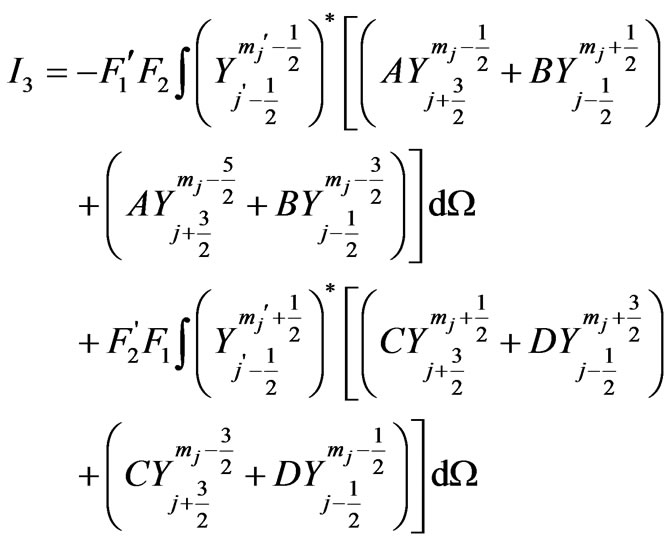 (14)
(14)
which will be non-zero for
 (15a)
(15a)
 (15b)
(15b)
Similarly substitution of Equations (5a) and (5b) in  we obtain:
we obtain:
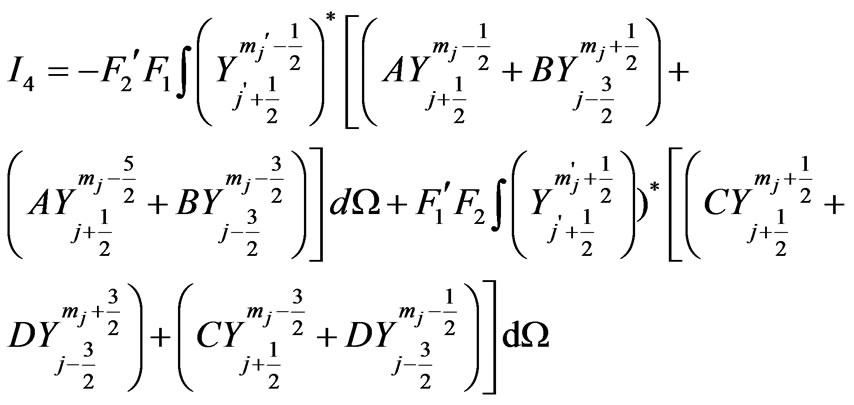 (16)
(16)
which will be non-zero for

 (17)
(17)
Next we consider the case (b):



+

 (18)
(18)
Substitution of Equation (5a) in  we obtain:
we obtain:
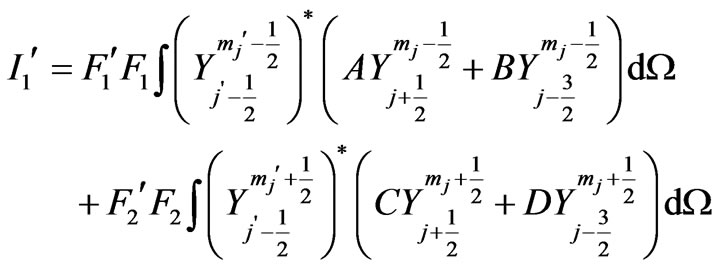 (19)
(19)
which will be non-zero for
 (20)
(20)
where we used the relations:
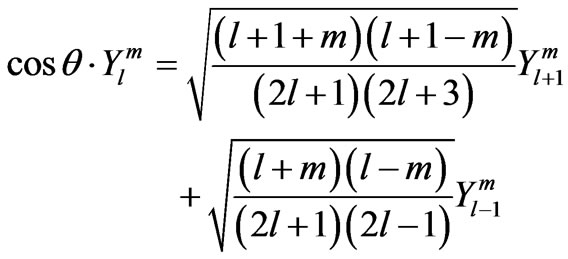 (21)
(21)
Similarly substitution of Equation (5b) in  we obtain:
we obtain:
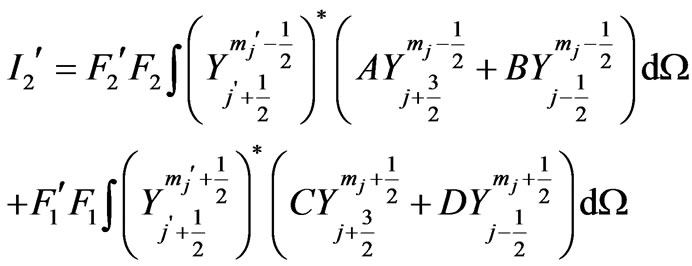 (22)
(22)
which will be non-zero for
 (23)
(23)
Substitution of Equations (5a) and (5b) in  we obtain:
we obtain:
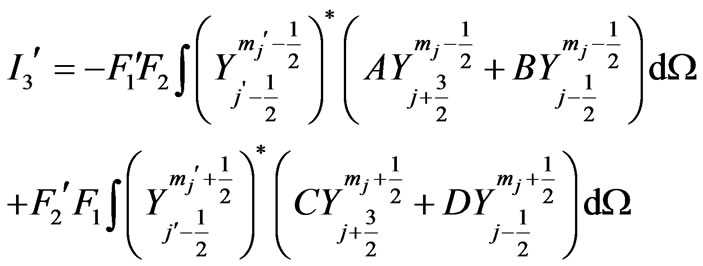 (24)
(24)
which will be non-zero for
 (25)
(25)
Similarly substitution of Equations (5a) and (5b) in  we obtain:
we obtain:
 (26)
(26)
which will be non-zero for
 . (27)
. (27)
So far we have considered the effect of the electric dipole transitions. If we want to add the effect of the magnetic field, we must take  as the perturbing potential. To calculate the matrix element
as the perturbing potential. To calculate the matrix element  , we will follow a similar way as we did above. Namely we will consider two different cases: a) The polarization of the magnetic field is in x-y plane (along the xor the y-axis) b) The polarization of the magnetic field is in z-direction. The only difference is that the magnetic moment vector
, we will follow a similar way as we did above. Namely we will consider two different cases: a) The polarization of the magnetic field is in x-y plane (along the xor the y-axis) b) The polarization of the magnetic field is in z-direction. The only difference is that the magnetic moment vector  will be proportional to (
will be proportional to (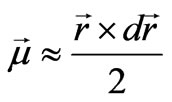 ), so
), so  will be perpendicular to the vector
will be perpendicular to the vector . Therefore for the case a) we calculate the matrix elements of the quantity rcos q and for the case b) we calculate the matrix elements of the quantity x ± iy= rsinq exp(±if ). That means for the case a) we will calculate the matrix elements
. Therefore for the case a) we calculate the matrix elements of the quantity rcos q and for the case b) we calculate the matrix elements of the quantity x ± iy= rsinq exp(±if ). That means for the case a) we will calculate the matrix elements  given in Equation (18) and for the case b) we will calculate the matrix elements
given in Equation (18) and for the case b) we will calculate the matrix elements  given in Equation (8). Therefore the selection rules of the magnetic dipole transitions will be the same as the selection rules for the electric dipole transitions. Combining the results of the Equations (10), (13), (15), (17), (20), (23), (25) and (27), we write the selection rules for a photonic transitions in Hydrogen-like atoms:
given in Equation (8). Therefore the selection rules of the magnetic dipole transitions will be the same as the selection rules for the electric dipole transitions. Combining the results of the Equations (10), (13), (15), (17), (20), (23), (25) and (27), we write the selection rules for a photonic transitions in Hydrogen-like atoms:

 (28)
(28)
4. Application of the Spin Dependent
Selection Rules to ( ) Transition in Cs According to the conventional selection rules (
) Transition in Cs According to the conventional selection rules ( and
and ) which are derived from the Schrödinger equation in the same way as in Section 3, a transition such as
) which are derived from the Schrödinger equation in the same way as in Section 3, a transition such as  is not allowed ( because this is a transition (
is not allowed ( because this is a transition (

 ) in which
) in which , so it does not meet the condition
, so it does not meet the condition ). But
). But  transition in Cs atom has been already observed [7-9]. However, the present spin dependent selection rules allow the transition:
transition in Cs atom has been already observed [7-9]. However, the present spin dependent selection rules allow the transition: 

 in Cs atom. Because here we have
in Cs atom. Because here we have and
and  which are allowed by the present spin dependent selection rules given in Equation (28). To prove the above transition in detail, let us assume that the outer electron of the Cs atom is initially at the state
which are allowed by the present spin dependent selection rules given in Equation (28). To prove the above transition in detail, let us assume that the outer electron of the Cs atom is initially at the state  =
= . From Equation (5a) we write:
. From Equation (5a) we write:
 (29)
(29)
where A is the normalization constant. When it is excited to the  state, the possible final states are:
state, the possible final states are:
 and
and .
.
From Equations (5a) and (5b) these states are:
 (30a)
(30a)
 (30b)
(30b)
where B, and C are the normalization constants. Substituting the wave functions from Equation (29) and Equations (30a)-(30b) in Equations (8) and (18) we find:
 (31)
(31)
 (32)
(32)
Therefore the non-zero matrix element in Equation (31) gives us a non-transition between the states  and
and  which is also allowed by the present spin dependent selection rules given in Equation (28) (
which is also allowed by the present spin dependent selection rules given in Equation (28) ( and
and ).
).
5. Conclusions
We have derived the spin dependent selection rules for photonic transitions in hydrogen-like atoms by using the solution of Dirac equation for hydrogen-like atoms. It is shown that photonic transitions occur when [ while
while ]. By applying the present spin dependent selection rules we can explain the observed (6 s
]. By applying the present spin dependent selection rules we can explain the observed (6 s 7 s) transition in Cesium (Cs) atom [7,8]. Because in the (6s
7 s) transition in Cesium (Cs) atom [7,8]. Because in the (6s 7s) transition in Cesium (Cs) atom we have [
7s) transition in Cesium (Cs) atom we have [ while
while ] which is an allowed transition according to the present selection rules given in Equation (28). The present result is believed to be helpful for a deeper understanding of the photonic transitions and the spectrum of Cs atom [1]. A detailed study will be presented in the future.
] which is an allowed transition according to the present selection rules given in Equation (28). The present result is believed to be helpful for a deeper understanding of the photonic transitions and the spectrum of Cs atom [1]. A detailed study will be presented in the future.
REFERENCES
- S. B. Bayram, S. Kin, M. J. Welsh and J. D. Hinkle, “Collisional Depolarization of Zeeman Coherences in the 133Cs 6p 2P3/2 Level: Double-Resonance Two-Photon Polarization Spectroscopy,” Physical Review A (Atomic, Molecular and Optical Physics), Vol. 73, No. 4, April 2006, pp. 42713-1-6. doi:10.1007/s10946-007-0015-6
- M. Saglam, Z. Saglam, B. Boyacioglu and K. K. Wan, “Quantized Magnetic Flux Through the Excited State Orbits of Hydrogen Atom,” Journal of Russian Laser Research, Vol. 28, No. 3, 2007, pp. 267-271. doi:10.1007/s10946-007-0026-3
- M. Saglam, B. Boyacıoglu and Z. Saglam, “Spin-Flip Investigation of 1s-2p and 2p-3d Transitions of Dirac Hydrogen Atom in Terms of the Flux-Quantization Argument,” Journal of Russian Laser Research, Vol. 28, No. 4, 2007, pp. 377-382. doi:10.1002/9783527618460
- D.Griffths, “Introduction to Elementary Particles,” John Wiley & Sons, Hoboken, 1987.
- M. Saglam, B. Boyacioglu and Z. Saglam, “Spin Dependent Selection Rules for Dipole Transitions in Hydrogen Atom,” The Journal of Old and New Concepts in Physics, Vol. 3, 2006, pp. 181-189.
- F.Constantinescu and E. Magyari, “Problems in Quantum Mechanics,” Pergamon Press, Oxford, New York, 1971.
- M. Lintz, J. Guéna and M.-A. Bouchiat, “Pump-Probe Measurements of Atomic Parity Violation in Cesium with Precision of 2.6%,” The European Physical Journal A, Vol. 32, No. 4, 2006, pp. 525-529. doi:10.1140/epja/i2006-10433-9
- S. Sanguinetti, J. Guéna, M. Lintz, Ph. Jacquier, A. Wasan and M.-A. Bouchiat, “Prospects for Forbidden-Transition Spectroscopy and Parity Violation Measurements Using a Beam of Cold Stable or Radioactive Atoms,” The European Physical Journal D, Vol. 25, No. 1, 2003, pp. 3-13. doi:10.1140/epjd/e2003-00215-5

